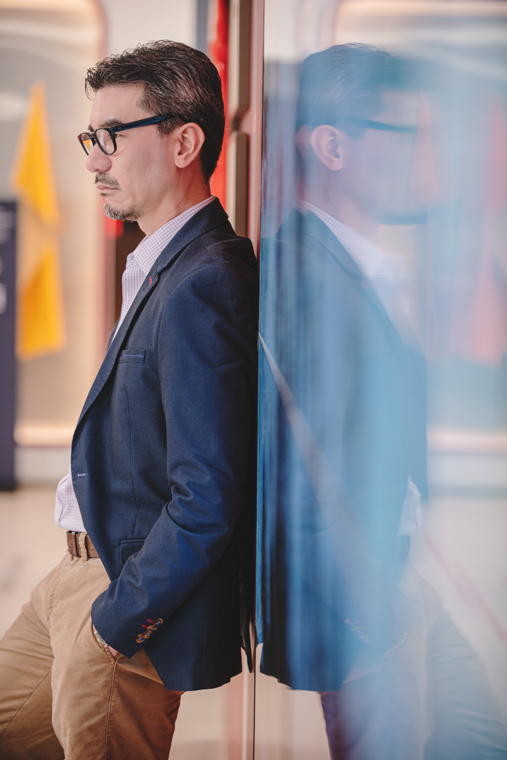 Gordon Lam, President, APJ, Syniti
Gordon Lam, President, APJ, Syniti
Gordon Lam, President, APJ, Syniti
The disruptions brought on by remote connectivity are pervasive. From the obvious ways of how we engage, communicate, or ideate with one another, to the subtle changes in buyer behaviors, and the decision-making process both in style and substance. These challenges have manifested beyond the physical distance, but also to mental and psychological distance, impacting mental health and adding on to work and personal stress. With an agile mindset, we were able to shift our priorities to our stakeholders and emphasize the importance of employee well-being. As a result, we established new programs and communication channels to stay connected while apart.
On Innovation and Data
There will be a lot of innovation around bridging the physical divide. In the 20th century it was all about trains, planes, and automobiles bringing people closer, and that is important as we are social beings – communication is much more than just the spoken and written words. In the new normal, we need to be able to create that proximity and intimacy as we engage, communicate, and share ideas while being miles apart.
The other area that is experiencing a tsunami level of innovation, and a topic close to my heart, is data. This is a pivotal moment as emerging technology like artificial intelligence, machine learning, big data, and IoT are creating tremendous shifts across all industries. Covid-19 has placed the rate of these innovations on steroids and all these shifts intersect at two pronounced technological intersections – silicon and data, which impacts every aspect of business and our daily lives. Organizations will therefore continue to prioritize their digital transformation journeys to build a robust digital infrastructure and ensure business continuity in a hybrid working environment.
(Related: Outlook 2022 Part 4)
 Abhayanand Singh, Co-Founder and Group CEO, Vistas Media Capital
Abhayanand Singh, Co-Founder and Group CEO, Vistas Media Capital
Abhayanand Singh, Co-Founder and Group CEO, Vistas Media Capital
With the pandemic accelerating multiple trends in the media and entertainment (M&E) industry, one of the challenges we encountered was responding to new consumer behavior patterns and acquiring technology-centric companies that can support digital consumption habits across these entertainment verticals - direct-to-consumer streaming services, music streaming distribution services and non-fungible token (NFTs), which we predict will only rise in demand in 2022.
On Venture Capital
Currently, the key M&E areas that allow for growth-oriented capital deployment strategies are interactive entertainment that offer consumers more immersive experiences, such as NFTs, metaverses, and blockchain gaming sectors. Leveraging NFT platforms enables film producers and media executives to bypass the traditional film financing route and are reshaping the way films are conventionally distributed.
With the demand for digital entertainment in Asia projected to reach a CAGR of 7.4% from the period of 2021 – 2026, more venture capital firms are refocusing in the MENA region as Middle East shifts towards the use of digital streaming technologies like Over-The-Top (OTT) streaming services. As entertainment and technology sectors continue to converge, there are many new fundraising and investment opportunities related to digital media, content streaming distribution, and hyperlocal content creation.
 Dave Giblin, Chief Customer Officer, Anchanto
Dave Giblin, Chief Customer Officer, Anchanto
Dave Giblin, Chief Customer Officer, Anchanto
Amid disruptions, the primary challenge came with 'people engagement', both internally and externally, as everyone shifted from a physical to a remote environment. To overcome this, we first implemented special tools and strategies to enable our team members to adapt to home-based working. Equipped with the right resources, they were able to deliver smooth experiences to our customers who faced similar challenges as us.
On E-Commerce
The acceleration of online purchasing led to an additional 70 million online shoppers in the Southeast Asia e-commerce market. However, as e-commerce, SaaS, and payment infrastructures continue to mature, many consumers now have higher expectations for e-commerce players to provide a seamless online-shopping experience based on factors like speed, accuracy, and convenience. Consumers expect on-demand deliveries, faster warehouse packaging, precision in tracking information, and better online customer service.
Given that customers do not differentiate between channels, omnichannel eCommerce is no longer a mere buzzword and has started materializing into reality. So the manifestation of innovation will not be limited to the customer front, but will occur right in the heart of ecosystem actors. In order to acquire cost-conscious shoppers and survive high competition in an oversaturated e-commerce market, agile, connected, and advanced technology like Anchanto OMS & WMS will play a crucial role in helping actors embrace this digital transformation.
 Nicolas Keravec, CFO, Zipmex
Nicolas Keravec, CFO, Zipmex
Nicolas Keravec, CFO, Zipmex
The pandemic has affected customer behavior and we had to ensure our offerings evolve with our customers who are seeking exclusive experiences and a diversified investment portfolio. We also had to navigate changes in regulatory policies and are committed to working with regulators to encourage the development of the digital assets ecosystem.
On New Technologies
The demand for decentralised finance services (DeFi), non-fungible tokens (NFTs), and payment applications is expected to increase. Going forward, we expect to see greater integration of crypto assets with traditional payment systems, such as credit cards. With more brands exploring NFTs as part of their product strategy, we also expect that NFTs will shift from being just collectibles to have more real-world utility, providing both sellers and buyers with new experiences and revenue streams. With more individuals embracing digital assets for wealth creation, regulators and industry stakeholders are studying the impact of such technologies and looking to integrate them on a larger scale. Many firms in the region are already implementing blockchain technology into their business, which will lead to the creation of value-added products and services for consumers. These include personal finance and lifestyle products that enable consumers to spend their digital currencies in retail, consumer goods and other sectors.
Tushar Vashisht, Founder and CEO, HealthifyMe
The pandemic has made consumers more health conscious. While the outlook for the health and fitness industry remains positive, varying levels of health literacy and consumer habits in the region means companies need to deliver localized and cutting-edge products to stand out in an increasingly competitive market.
On New Technologies
Exercising online and using healthcare apps is a phenomenon that has been present even before the pandemic. However, Covid-19 has normalized the use of digital solutions in health and fitness, transforming industry norms as more people recognize the value of such platforms.
Looking beyond the pandemic, we foresee wider mainstream adoption with more digital monitoring solutions available. This does not only include fitness apps, but digital health solutions such as devices, apps, and information from certified experts that help consumers be more engaged and empowered to manage their own health.
In particular, solutions that offer an interactive experience for users may have a competitive edge compared to their peers, as they are able to successfully replicate the collaborative aspect of exercising with one’s friends or a trainer.
Arthur Cheong, Founding Partner, DeFiance Capital
Decentralized finance’s strong growth over the past year was accompanied by the exploitation of a number of high-risk security vulnerabilities. These exploits affected DeFi’s reputation significantly among media and investors. Subsequently, our communication pivoted towards an objective, nuanced perspective on the exploits – a characteristic of a maturing industry.
On New Technologies
Innovation is picking up in the crypto world in general and the DeFi space in particular. We expect 2022 to be dominated by three things:
Ethereum 2.0 – Ethereum remains the king of DeFi, despite the growth of key challengers, such as Solana and Terra. To stay competitive and improve its environmental record, Ethereum plans to move to a new consensus algorithm next year that allows users to stake their ETH to secure the network.
Metaverses – We will see more examples of bridging metaverses with the physical world, such as how Barbados announced plans to open an official embassy in the Decentraland metaverse.
Non-fungible tokens (NFTs) – NFTs have exploded in popularity, serving as a new distribution channel for the art, media, gaming, and entertainment industries and a platform for artists to monetise their work. We believe the NFT market is here to stay as it adapts to the creative preferences of a digital generation.
 Chris Halim, Co-Founder and CEO, Style Theory
Chris Halim, Co-Founder and CEO, Style Theory
Chris Halim, Co-Founder and CEO, Style Theory
Covid-19 has been one of the biggest challenges we’ve faced as a young homegrown company. Most of our customers are working adults, so the introduction of work-from-home as a default and restrictions on gatherings meant that people went out less, and therefore have a lower need for workwear or occasion wear. Yet, we’re witnessing newer doors opening up for us. We discovered that even as the demand for rental eased, there was still high interest in designer resale offerings. While resale has been a core pillar of our business since 2020, we began to direct more attention to it last year and eventually established a dedicated resale platform, Second Edit by Style Theory.
On the Fashion Industry
The pandemic has undoubtedly left its mark on the fashion industry – consumers have become more conscious of their relationship with clothing, consumption and waste; for example, people are questioning if they truly need that much clothing or if they need to buy new clothes often. This attitude may well continue into a world where Covid-19 is endemic. Lasting cultural and societal changes, such as hybrid working models and a growing awareness of environmental concerns may result in preference for a model of fashion consumption that is circular at its core, which also offers more flexibility to consumers. Flexibility for consumers: As consumption preferences change according to norm shifts in work and play, consumers need new models of clothes consumption that reflect the fluidity of their lifestyles. Businesses need to take this into account as they design products for the post-pandemic consumer.
 Kelvin Lim, Executive Director and Chairman, LHN Group
Kelvin Lim, Executive Director and Chairman, LHN Group
Kelvin Lim, Executive Director and Chairman, LHN Group
Deploying technology at faster speeds had to be done to facilitate property viewings safely and adhere to social distancing measures. We quickly accelerated our digitalization efforts by bringing viewings to life through virtual means with Matterport. This new technology allows 3D tours of properties with a 360-degree view, so interested prospects can get an immersive experience without being physically onsite.
On Real Estate
The pandemic has reshaped the entire real estate industry. Companies downsized their workspace as more adopt remote working flexible work arrangements, causing the steep drop in demand for traditional office spaces. On the other hand, the demand for co-working spaces with flexible lease continues growing.
The e-commerce industry has also grown rapidly during this period. This shift will further boost the high demand for industrial spaces. With the self-storage industry growing alongside the e-commerce market share, the need for a physical storage space, alongside a full suite of value-added services and facilities, such as packing stations, livestreaming/photography studios, and last-mile delivery, will become the norm.
Lastly, the pandemic also resulted in a surge in co-living spaces. This trend reflects the high occupancy rate of our Coliwoo properties with over 90%. It can be attributed to people requiring more flexible living arrangements as they face delays in BTO flat completions, millennials moving out of their family homes for more productive environments amidst work- from-home arrangements, and expats looking for a more affordable alternative.
Srinivas Gattamneni, CEO, ADA
Our challenge was remaining consistent in delivering value-added outcomes for our clients despite the unpredictability of the market. Aside from leveraging the market insights on-hand, we also focused on building stronger relationship with clients to better understand how we can develop a performing data-driven strategy amidst the new circumstances together.
On New Technologies
Moving forward, the focus is on making the consumer’s journey as personalised and frictionless as possible. In terms of new applications, brands are looking towards adoption of more engaging digital touchpoints, such as shoppable advertising to accelerate the customer acquisition process from discovery to purchase, especially as consumers transition towards digital retail. The integration of AI into critical parts of the customer experience to help predict customer behavior and deliver more personalized content will also become increasingly popular.
The industry is also paying close attention to emerging technologies like Extended Reality (XR) and the Metaverse – especially with consumers’ increasing focus on experiences. Whether it is delivering a hybrid retail experience through XR or an all-new digital journey with the Metaverse, brands looking to stay relevant are investing heavily into partnership with existing players within the respective space to turn the customer journey into a thoughtful, memorable experience.
 Anita Jiawen Sadasivan, Co-Founder & Chief Wellbeing Officer, MindFi
Anita Jiawen Sadasivan, Co-Founder & Chief Wellbeing Officer, MindFi
Anita Jiawen Sadasivan, Co-Founder & Chief Wellbeing Officer, MindFi
At the peak of the pandemic when remote working was enforced, organizations looked for ways to look after their employees while keeping them connected. We responded by creating an app-based team challenge to encourage employees to take charge of their mental health together.
On Mental Health Tech
Mental health awareness, along with the normalization of remote and hybrid work, has led to a surge in demand for corporate mental health solutions that are effective, affordable, and suitable for remote delivery. Immense innovation has taken place as technology enters this traditionally human-centered field to offer self-care programs, chatbots, and teletherapy. These solutions draw from science-backed therapeutic interventions such as cognitive behavioral therapy and mindfulness, and are rapidly increasing in sophistication as artificial intelligence begins to play a bigger role in customizing and digitizing the therapeutic experience. Corporations are increasingly recognizing the need to provide mental health support to their employees, and I believe we will see continued growth as more organizations commit to supporting the wellbeing of their employees.
 Suresh Venkataraya, CEO, AWAK
Suresh Venkataraya, CEO, AWAK
Suresh Venkataraya, CEO, AWAK
Being an R&D entity, working from the office was crucial and it initially caused us to face issues with balancing the workload on key project, as well as maintaining the well-being of employees. We implemented stringent social distancing measures and arranged employees to come in staggered groups during the peak of the pandemic.
On New Technologies
I believe that technology will be further ingrained into our lives through the application of medical treatments in the comfort of one’s home. With the surge in remote monitoring due to Covid-19, it created a momentum that will give rise to improvements of medical technology in the years to come. We will see a pickup on the advancement of medical technology in all aspects, but especially for managing chronic diseases at home. On top of that, new laws are being put in place to help support the home-based therapy model, thus we believe that this is the direction medical technology will follow.
Shot on location at Ferrari Singapore (Ital Auto Pte Lted)
30 Leng Kee Road, Singapore, 159100
 Nick Jonsson, Co-founder & CEO, Executives’ Global Network
Nick Jonsson, Co-founder & CEO, Executives’ Global Network
Nick Jonsson, Co-founder & CEO, Executives’ Global Network
Covid-19 has impacted EGN Singapore to a massive degree, changing how we forge business relationships with each other. Gone are the days where you could meet others at an industry conference or gala dinner for networking. However, networking during the pandemic has become more of a necessity than an option. In response to the needs of the time, we have pivoted our physical events to a hybrid that combines in-person and virtual and we made our content more personalized and holistic so our 550+ members can still make meaningful connections in spite of the distance.
On Diversity & Inclusion
I believe that the future growth of companies is highly dependent on diversity. As we rebuild economies, reopen business and reconfigure our workplaces in 2022, we also have an opportunity to hardwire inclusivity and equality into tomorrow's workplaces. To restore equity and inclusion that the pandemic has disrupted, especially in the workplaces, companies should be committed to recruiting 50 per cent female talent into job roles that significantly impact their organization. Another strategy is to develop a robust gender-equal reward system that addresses bias and ensures equal pay and opportunity for all staff. A good leader should also facilitate women employees having a voice and reflecting upon the challenges the women in her life have to promote equality in the workplace. Efforts such as these will improve diversity and inclusion and help the company survive the economic crisis by bringing in new talent for the jobs of tomorrow while also boosting the local economy – a win for everyone involved.
 Eddie Stefanescu, General Manager - Asia Pacific & Japan, Claroty
Eddie Stefanescu, General Manager - Asia Pacific & Japan, Claroty
Eddie Stefanescu, General Manager - Asia Pacific & Japan, Claroty
The pandemic caused a drastic rise in remote work, and network administrators of operation technology (OT) networks are on the front lines of enablement. They need to provide online connectivity to users who typically access industrial control systems physically, while remaining confident that security isn’t compromised. The task is significant as every company in the world relies om these networks. For nearly half of the Fortune 2000—in industries including oil and gas, energy, utilities, manufacturing, pharmaceuticals, and F&B—these networks are critical components to their business, while the rest rely on OT networks to run their office infrastructure (lights, elevators, data center infrastructure, etc.). The less staff that an organization has on site, the greater the need for secure remote access solutions.
On Cybersecurity Solutions
Enterprises have realized that their IT solutions for cybersecurity do not work for industrial applications. Along with this cognizance, governments will commence regulating public and private sector enterprises to ensure they protect what is in the public interest, especially from ransomware. For these reasons, there will be a greater adoption of cybersecurity solutions that are purpose-built for industrial environments.
However, the issue goes beyond that. The role of the Chief Information Security Officer (CISO) is also evolving. It hasn’t traditionally been a business role, but one of the consequences of digital transformation is that enterprises are ever more vulnerable to security breaches, especially when it’s their data at risk, and thus the role of the CISO in the near future could answer to the CEO, and perhaps, the Board of Directors.






 Gordon Lam, President, APJ, Syniti
Gordon Lam, President, APJ, Syniti
 Abhayanand Singh, Co-Founder and Group CEO, Vistas Media Capital
Abhayanand Singh, Co-Founder and Group CEO, Vistas Media Capital
 Dave Giblin, Chief Customer Officer, Anchanto
Dave Giblin, Chief Customer Officer, Anchanto
 Nicolas Keravec, CFO, Zipmex
Nicolas Keravec, CFO, Zipmex
 Chris Halim, Co-Founder and CEO, Style Theory
Chris Halim, Co-Founder and CEO, Style Theory
 Kelvin Lim, Executive Director and Chairman, LHN Group
Kelvin Lim, Executive Director and Chairman, LHN Group
 Anita Jiawen Sadasivan, Co-Founder & Chief Wellbeing Officer, MindFi
Anita Jiawen Sadasivan, Co-Founder & Chief Wellbeing Officer, MindFi
 Suresh Venkataraya, CEO, AWAK
Suresh Venkataraya, CEO, AWAK
 Nick Jonsson, Co-founder & CEO, Executives’ Global Network
Nick Jonsson, Co-founder & CEO, Executives’ Global Network
 Eddie Stefanescu, General Manager - Asia Pacific & Japan, Claroty
Eddie Stefanescu, General Manager - Asia Pacific & Japan, Claroty




 Back
Back
